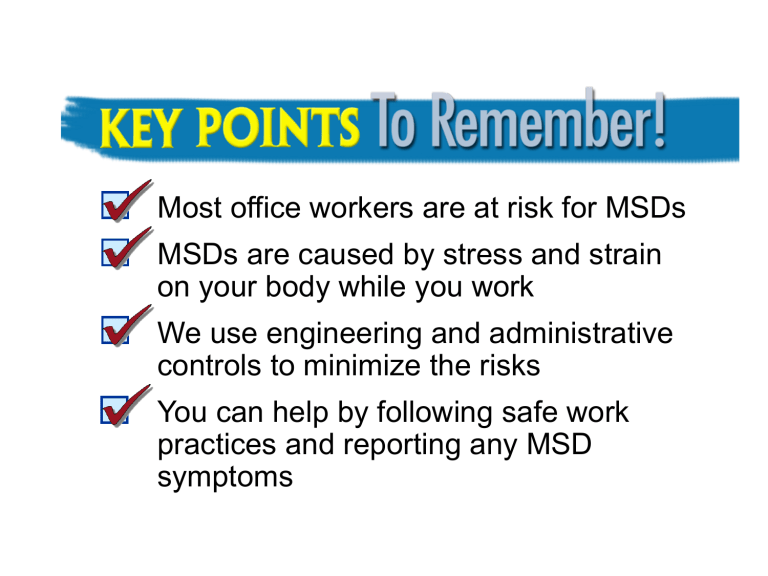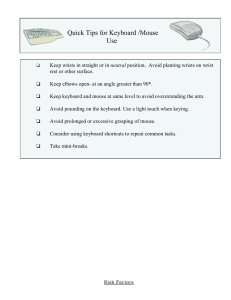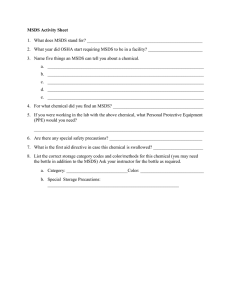
Key Points to Remember Most office workers are at risk for MSDs MSDs are caused by stress and strain on your body while you work We use engineering and administrative controls to minimize the risks You can help by following safe work practices and reporting any MSD symptoms MSD Prevention • Do you understand: • Proper computer workstation setup? • Chair adjustments? • Neutral keyboard position? • Proper use of mouse? • Tips for using laptops? • Importance of breaks? • Stretching exercises to relieve stress and strain? MSD Prevention: Pick the Right Answer While working on the computer, elbows should be: a. Extended out Computer monitor should be positioned: a. In front of you While you’re typing, your wrists should be: Control the mouse with: b. Close to body b. To one side a. Bent up b. Straight a. Wrist movements b. Elbow movements Focus on Your Posture • Elbows at sides, forearms parallel to floor • Wrists in neutral position • Good back support • Feet flat on floor • Head and neck facing forward and straight • Relax shoulders Exercises (cont.) Neck • Nod head • Turn head • Tilt head Back/arms • Hands behind head • Bend forward • Knee to chest • Back bend Exercises Hands • Finger extensions Wrists • Backwards stretch Shoulders • Shrug and roll • Blade pinch • Overhead reach Break Time • Minibreak: – Relax your hands • Rest break: – Do a different task • Eye break: – Look away and blink Using a Laptop • Occasional users – Sacrifice neck posture rather than wrist posture – Sit back in a comfortable chair and adjust laptop • Full-time users – Position screen like workstation monitor – Use separate keyboard and mouse Using a Mouse • Control mouse movement from the elbow • Keep wrist straight in neutral position • Position the mouse properly • Switch mouse to other side if you feel stress Neutral Keyboard Position • Elbows close to body and bent about 90 degrees • Wrists flat and in line with forearms • Hands not angled up/down or turned in/out • No wristrest when typing Computer Monitor • Directly in front of you • Arm’s length away • Proper height so head is level • Documents placed close to monitor Chair Adjustments: Back and Arms • Backrest with adjustable angle and lumbar support • Armrest broad and cushioned to support shoulders, elbows, and wrists • Armrests independently adjustable in height and side to side Image Credit: Ergogenesis, LLC Chair Adjustments: Seat Surface • Comfortable • Slightly wider than hips/thighs • Proper length • Adjustable height • Adjustable tilt Computer Workstation: Legs and Feet • Knees bent about 90 degrees • Thighs parallel to floor • Chair at a comfortable height • Obstructions removed • Feet flat on the floor or on a footrest Computer Workstation: Elbows and Wrists • Elbows relaxed and close to the body • Elbows not extended forward or backward • Wrists in a straight line with lower arms • Hands not flexed up or down, or bent inward or outward Computer Workstation: Head and Shoulders – Head vertical and facing forward – Tilted head puts stress on neck and shoulders – Minimize head rotation – Shoulders relaxed – Arms tucked close to body – No extended reaching Ergonomics and MSDs • Do you understand: • What ergonomics is? • Ergonomic risk factors? • What MSDs are? • MSD symptoms? • MSDs that affect office workers? Ergonomics and MSDs: True or False? Ergonomics reduces exposure to MSD risk factors MSDs affect only the wrists An example of an engineering control to prevent MSDs is alternating tasks Report MSD symptoms only after you’ve seen a doctor What Should You Do if You Experience Symptoms? • Report MSD symptoms immediately • Seek medical treatment • Cooperate in reducing risk factors on the job What Will the Pain Be Like? Tightness Stiffness Discomfort Soreness Burning Tingling Coldness Numbness Tightness What Are the Risk Factors? – Repetition – Awkward postures – Contact stress – Force and vibration What Are MSDs? • • • • • • • Injuries or disorders involving: Muscles Tendons and ligaments Joints Cartilage Blood vessels Nerves Session Objectives Define ergonomics and MSDs Identify ergonomic risk factors Recognize MSD symptoms Set up your workstation to minimize stress and strain Perform tasks safely and avoid injuries and illness

